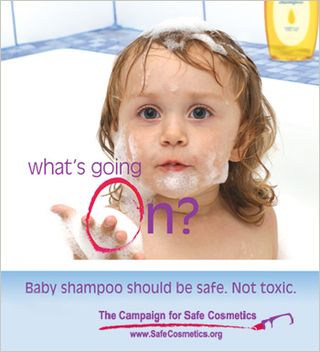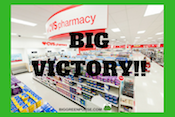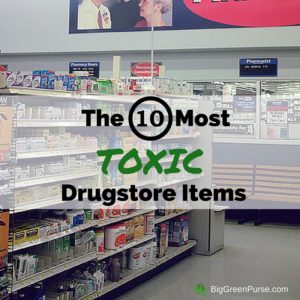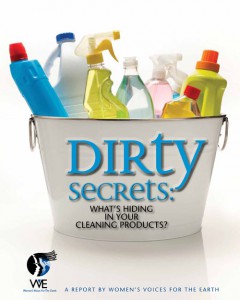Nothing should give you greater peace of mind than to give your baby a bath and know she’s come out squeaky clean.

The Campaign for Safe Cosmetics commissioned an independent laboratory to test 48 products for 1,4-dioxane; 28 of those products were also tested for formaldehyde. The lab found:
* 1,4-dioxane in 67 percent of the products.
* Formaldehyde in 82 percent of those tested.
* Seventeen products contaminated with both 1,4-dioxane and formaldehyde.
The full list of products tested is in the Campaign’s report, “No More Toxic Tub.” They include: Johnson & Johnson’s baby shampoo, Baby Magic “Soft Baby Scent” Baby Lotion, and American Girl “Hopes & Dreams” Glistening Shower and Beth Wash.
Why does this matter?
Formaldehyde and 1,4-dioxane are known carcinogens; formaldehyde can also trigger skin rashes in some children. Unlike many other countries, the U.S. government does not limit formaldehyde, 1,4-dioxane, or most other hazardous substances in personal care products.
The toxins are not listed on the ingredients label because, the way the law is written, they’re not required to. And manufacturers of products that contain toxins like these often discount their impact, saying they pose no threat because they’re present in such minute amounts.
The National Academy of Sciences disagrees. NAS says several factors contribute to children’s special vulnerability to the harmful effects of chemicals:
• A child’s chemical exposures are greater pound-for-pound than those of an adult.
• Children are less able than adults to detoxify and excrete chemicals.
• Children’s developing organ systems are more vulnerable to damage from chemical exposures.
• Children have more years of future life in which to develop disease triggered by early exposure.
What can you do?
* Search the Skin Deep data base maintained by Environmental Working Group to find safer alternatives to the products identified in the Campaign’s report.
* Contact Johnson & Johnson, and urge them to clean up their products by removing dangerous ingredients like 1,4 dioxane and formaldehyde. Here is the e-mail I just sent:
I have recently learned that J&J baby soaps contain 1,4 dioxane and formaldehyde. These are known carcinogens to which no child should be exposed. Please remove these compounds from all your products immediately. Until you do, I will cease to be a J&J customer.
*Write to Rep. Henry Waxman, Chairman of the House Energy and Commerce Committee, with responsibility for legislation and oversight in the areas of public health, consumer protection, food and drug safety, and the environment.Urge Rep. Waxman to convene hearings on toxic ingredients in baby products.
2204 Rayburn House Office Building
Washington, D.C. 20515
Telephone (202) 225-3976
Fax (202) 225-4099
* Write your own Senators and Representative and urge them to support the Kid-Safe Chemical Act, legislation that would strengthen laws and regulations to protect kids from toxins in all products – including baby soap and shampoo.

















10 thoughts on “Should Soap Bubbles Make Your Baby Sick? Tell J&J No!”
Great ideas here Diane! So glad you included your email copy and Rep. Waxman’s address. Now let’s all get busy and write those letters!
Great action items – even for someone like me without Congressional representation! 😉
I am glad I don’t have to contact my Senator since he is sponsoring the bill!!! Yay, Senator Lautenberg! I did contact him anyways.
Maybe we should do a carnival addressing letters to Rep Waxman?
oooh great resources and examples to voice concerns Diane – thank you
Yes, writing a carnival full of letters to Waxman is a great idea!
Well, anything that numbs your eyes has to have a load of bad ingredients in them. Just because these companies are trying to green up their image doesn’t mean they are really moving forward. I think that the care of our babies has to be the first and foremost. Glad you shared this with so many.
Diane, thanks for this great contribution to the Green Moms Carnival.
I’d like to point out that the comment left by Eric McErlain is left by a PR rep for the Formaldehyde Council. He has been making the rounds on all our blogs posting the same two articles as “proof” that we are all “panicking,” although in other posts he uses the word “hysterical.” Nice PR, huh? Alienate your client’s customers?
Anyway, we have momentum on our side. Since writing my post for this Green Moms Carnival, I have been blown away by the information I have unearthed showing links back TWENTY YEARS or more and also the many, many breast cancer, environmental, nursing and health organizations that support the Campaign for Safe Cosmetics.
I’d like J&J to respond to us openly and honestly and stop hiding behind their standard comment “It’s important to stress that all our products are within the FDA limits.”
We know that. It’s the FDA limits that are the issue.
Great post, Diane. Our voices are louder and more powerful together.
And thanks for the comment on spring clearning on Non-Toxic Kids re: vaccuming; it made me laugh out loud. Do you really put it in the middle of the floor?
And I would love to cross link to your site on my blogroll, and be on yours. What do you think?
Katy
http://www.non-toxickids.net
Thanks for this valuable and important information. I think there is need for families to undergo their mind setup and depend on major organic products. Because organic elements will have a less effect on the baby body. Though organic products require some inorganic materials in its ingredients but the actual percentage or composition of the organic content is much higher to about 80% in its ingredients. So chemical disturbances may be less with respect to the inorganic products.
By maintaining budget in organic food you can save money and health.
Comments are closed.